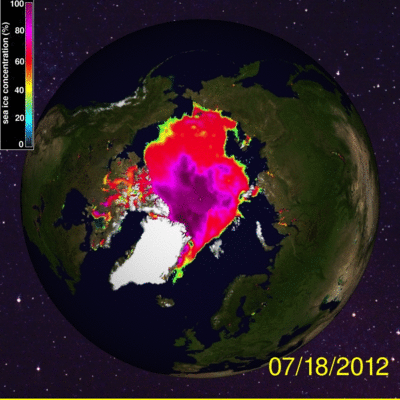~In search of intricate thermal patterns within sea ice.
Latest refraction observations do not always match mass buoys data at similar latitudes to 74 North, this is quite interesting, it is not a matter of reconciling the data with observations, but rather understanding if there is any way of revealing the most intimate thermal actions, and also finding out if there is data error by solar radiation affecting top buoy thermistors . The information readily available is sparse, resolution is not as desired, but there is some basic numbers which come out quite well.
Latent heat of fusion dictates when ice freezes there is a substantial release of heat, it is rather energy from extremely kinetic molecules stabilizing to a crystallin form, this energy may be observed near the North Pole, there is a
buoy moving under the presence of permanent sun rays hitting the sea ice surface continuously except by clouds and snow cover;
"04/30/2015 08:00"," 88.6400"," -23.6731","GPS"," -10.83"," 1025.60"," 0.06"," 1.89"," 0.00"," -1.89"," -10.45"," -10.45"," -10.47"," -10.56"," -10.50"," -10.42"," -10.01"," -9.97"," -9.88"," -9.82"," -9.64"," -9.35"," -9.12"," -8.82"," -8.53"," -8.00"," -7.75"," -7.40"," -7.02"," -6.67"," -6.24"," -5.89"," -5.57"," -5.04"," -4.64"," -4.15"," -3.71"," -3.22"," -2.73"," -2.25"," -1.81"," -1.86"," -1.78"," -1.83"," -1.81"," -1.79"," -1.81"," -1.80"," -1.79"," -1.78"," -1.80"," -1.82"," -1.80"," -1.82"," -1.84"
"04/30/2015 09:00"," 88.6394"," -23.6587","GPS"," -11.24"," 1025.71","","","","","","","","","","","","","","","","","","","","","","","","","","","","","","","","","","","","","","","","","","","","","","","","",""
"04/30/2015 10:00"," 88.6388"," -23.6399","GPS"," -11.03"," 1025.71","","","","","","","","","","","","","","","","","","","","","","","","","","","","","","","","","","","","","","","","","","","","","","","","",""
"04/30/2015 11:00"," 88.6382"," -23.6171","GPS"," -10.74"," 1025.74","","","","","","","","","","","","","","","","","","","","","","","","","","","","","","","","","","","","","","","","","","","","","","","","",""
"04/30/2015 12:00"," 88.6377"," -23.5929","GPS"," -10.61"," 1025.74"," 0.06"," 1.88"," 0.00"," -1.88"," -10.19"," -10.19"," -10.20"," -10.29"," -10.24"," -10.11"," -9.89"," -9.87"," -9.79"," -9.75"," -9.59"," -9.32"," -9.10"," -8.80"," -8.51"," -7.98"," -7.73"," -7.38"," -7.00"," -6.65"," -6.22"," -5.88"," -5.56"," -5.03"," -4.64"," -4.14"," -3.71"," -3.22"," -2.73"," -2.25"," -1.80"," -1.86"," -1.78"," -1.83"," -1.81"," -1.79"," -1.82"," -1.80"," -1.79"," -1.77"," -1.80"," -1.82"," -1.80"," -1.82"," -1.84"
"04/30/2015 13:00"," 88.6371"," -23.5673","GPS"," -10.61"," 1025.81","","","","","","","","","","","","","","","","","","","","","","","","","","","","","","","","","","","","","","","","","","","","","","","","",""
"04/30/2015 14:00"," 88.6366"," -23.5423","GPS"," -10.66"," 1025.74","","","","","","","","","","","","","","","","","","","","","","","","","","","","","","","","","","","","","","","","","","","","","","","","",""
"04/30/2015 15:00"," 88.6360"," -23.5206","GPS"," -10.62"," 1025.81","","","","","","","","","","","","","","","","","","","","","","","","","","","","","","","","","","","","","","","","","","","","","","","","",""
"04/30/2015 16:00"," 88.6355"," -23.5003","GPS"," -10.64"," 1025.53"," 0.06"," 2.01"," 0.00"," -2.01"," -10.19"," -10.19"," -10.13"," -10.21"," -10.17"," -9.96"," -9.69"," -9.75"," -9.70"," -9.69"," -9.54"," -9.28"," -9.07"," -8.78"," -8.49"," -7.96"," -7.71"," -7.35"," -6.98"," -6.64"," -6.21"," -5.87"," -5.55"," -5.02"," -4.63"," -4.14"," -3.71"," -3.22"," -2.73"," -2.26"," -1.81"," -1.85"," -1.78"," -1.83"," -1.81"," -1.79"," -1.81"," -1.81"," -1.80"," -1.77"," -1.81"," -1.82"," -1.81"," -1.83"," -1.84"
A good 230 cm (in red) of sea ice and snow has warmed when apparently 13 cm of ice was made at the bottom of the sea ice column, on april 30 sea ice thickness varied between 187 and 202 cm for weeks. But a 13 cm gain is quite an accomplishment, especially considering surface temperature nearly equal, or if not equal to snow surface top (in orange). The weather during the 8 hours presented was likely a mix between clouds and some sunshine. But more clouds than sun. In effect the variable but warmish polar weather is unique on Earth except at other end of the planet. There is no diurnal temperature effect similar to a normal day at Southern latitudes. An excellent location to observe thermal fluctuations at nearly constant sun light. Clouds add complications which need be studied as well.
Near North Pole Buoy clearly confirms unusual bottom of ice activity, which should happen when Ta = Ti, when air temperature is equal to snow/ice, there should be melting in the sheet bottom, but the melting in itself should be complex. Bottom ice may be less salty than sea water, a to and fro melt and freeze may happen often with different temperatures when less salty ice melts an lays less dense water on top of denser sea water. Over summer if high latitude near the pole ice survives , it can only create fantastic s
tructures of odd geometries. Sea Ice bottom is not as flat as on its surface.
Looking at 2015d buoy from a distance would not show a great horizon height variation because Ta=Ti, the horizon would be at the true astronomical elevation.
If 13 cm was formed as suggested by this data, latent heat was released,
which appears to have been recorded at some height above the ice sea water interface.
Top of sea water has also cooled compared to 4 hours prior (in blue).
Subsequent to April 30, the ice has no accreted further than 201 cm, suggesting
a state of thermal equilibrium, when bottom melting and freezing may happen by weather fluctuations. It is exactly like what happens to sea ice further South with a diurnal high and low sun but for shorter time period after local apparent noon, except noon is dragged out for months until a few weeks before autumnal equinox, however with much weaker radiation input from a much lower in sky but steady sun. From now own we can determine that ice accretion can no longer happen greatly as the sun will rise to more than 21 degrees high. Further South sea ice goes through far more severe thermal fluctuations, which highlights two types of sea ice, North Pole ice should not fracture as easily and is under less stress than sea ice with a sun 30 to 40 degrees high at noon then setting or staying up low at midnight. I proposed southern sea ice melting occurs after noon when sunny, but refreezing occurs later, reducing or stalling accretion, this melting freezing process continues only interrupted by winds and clouds until solstice sun melts ice quite thoroughly, but it must break up more readily than at the pole. wd May 3,2015








































